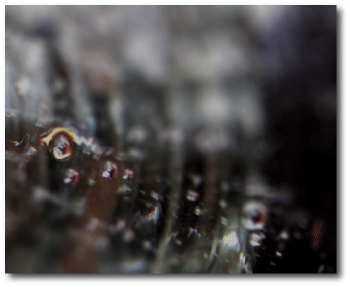
When I got home last Saturday, Sirius had just risen above the neighbors’ roof. The air was dramatically clear. In spite of the Santa Cruz city lights, I could make out stars down to fourth magnitude. The seeing, however, must have been incredibly bad, with a large amount of turbulence at high altitude. Sirius was twittering stochastically from white and blue to brief moments of intense, unmistakable fire-engine orange. Scintillation has got to be at the root of the red Sirius anomaly.
The back of every introductory astronomy textbook contains separate one-page lists of the nearest stars to the Sun and the brightest stars in the sky. I’ve never paid much attention to the lists of brightest stars. Rigel, Deneb, and Hadar are hundreds of parsecs away, hot-tempered, short-lived and ultimately rather tiresome. It’s more interesting to pore over the lists of nearest stars. Alpha Centauri, Eta Cassiopeiae, Tau Ceti, 61 Cygni, Barnard’s star…
It’s always seemed odd to me that Sirius and Alpha Cen are at or near the top of both lists. Sirius, the brightest star in the sky, is in the fifth-nearest system, and Alpha Cen A, the fourth-brightest star is in the nearest system. It’s as if Henry Winkler lived three houses down your street in one direction and Barry Manilow lived five houses up the street in the other direction.
Over a lifetime, the constellations seem fixed, but on geologic timescales, the Sun rapidly drifts through completely new lists of nearest stellar neighbors. A kilometer per second is a parsec in a million years, and stars in the solar neighborhood have a velocity dispersion of ~30 km/sec. This means that the list of nearest 100 stellar systems undergoes a complete turnover roughly every 300,000 years, and over Earth’s 4.5 billion year lifetime, the tables in the back of the Astronomy 101 textbooks have gone through thousands of completely different editions.
The Hipparcos catalog multi-parameter search tool lists 1549 stars with distances less than 25 parsecs. For stars like Alpha Cen B and Sirius, this list is complete. That is, if we go out to 25 parsecs, we know about all the K0V stars, whereas the census of the lowest-mass (and hence extremely dim) red dwarfs is significantly incomplete beyond five parsecs or so. The 1549 nearest stars in the Hipparcos catalog all have their apparent V magnitudes listed and these are easily converted to absolute magnitudes since the distances are known to high accuracy. With the absolute magnitudes in hand, I wrote a short program that repeatedly draws new random 3D distributions of the 1549 stars within our 25-parsec sphere. By doing this, it’s possible to get a sense of how unusual it is to have stars like Sirius and Alpha Cen B essentially right next door. Given that this is just a blog post, I ignored any modifying effects arising from individual stars adhering into binary and multiple systems.
First, Sirius. I ran 1,000 trials, and filtered for instances in which a star that is instrinsically as bright or brighter than Sirius lies as close or closer than Sirius’ current 2.64-parsec distance. This condition was satisfied in 31 of the trials, and in one trial, two stars fit the bill. In a rough sense, then, the presence of Sirius is “unusual” at the 3% level.
As Oklo readers are no doubt aware, I’m rooting for a high-cadence Doppler velocity campaign on Alpha Cen B. The relevant question in this case is: What are the odds that we have a stellar neighbor that is as visibly bright or brighter than Alpha Cen B (V<1.34) with an absolute magnitude equal to or fainter than B (Mv>5.71)? We want a bright star so that a smaller telescope can be used, and so that a maximum number of observations can be made. We want an intrinsically dimmer cooler star because the radial velocity method works at the peak of its ability with K-type dwarfs, and because the radial velocity half-amplitude at given mass is larger and because the habitable zone is closer to the star.
Interestingly, adopting this criterion, Alpha Cen B is also unusual at the 3% level. In 1000 trials, a star that’s intrinsically dimmer than Alpha Cen B that (as a result of proximity) is visibly brighter on the sky occurred 28 times, and in one instance, two such stars made the grade.
Alpha Cen B is special for a number of other reasons: (1) metallicity, (2) binary plane orientation, (3) presence of Alpha Cen A as a control star, (4) sky position, (5) age. It’s sort of like having it turn out that Bono lives right next door.

So does the ratio of A stars to K stars equal the cube of the ratio of the distances between those two systems?
Cool point. To zeroth order, that’s correct.
Sirius is almost exactly twice the distance of Alpha Cen. Main sequence A stars like Sirius are, however, somewhat more than 8x rarer than early K main sequence stars like Alpha Cen B. The shortfall in bright Sirius-type stars (to get to ~3% for both) is made up by the scattering of somewhat evolved stars in the local 25pc volume. Also, the 1-sigma error on the 3% “unusualnesses” in the particular simulation that I did is ~(sqrt(30)/30)*0.03, which is ~0.5% for both stars. Were I a perfectionist, I would have stated 3+/-0.5% for both.
What is the probability that the brightest close star in any given run will be brighter than Canopus? That might give us a better feel for how unusual it is for bright and close to be correlated.